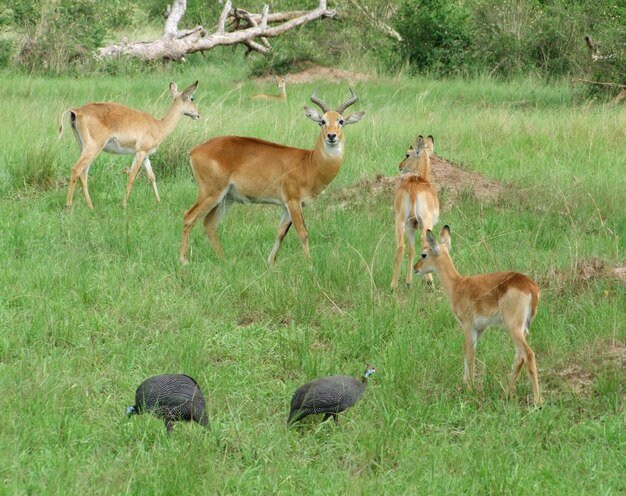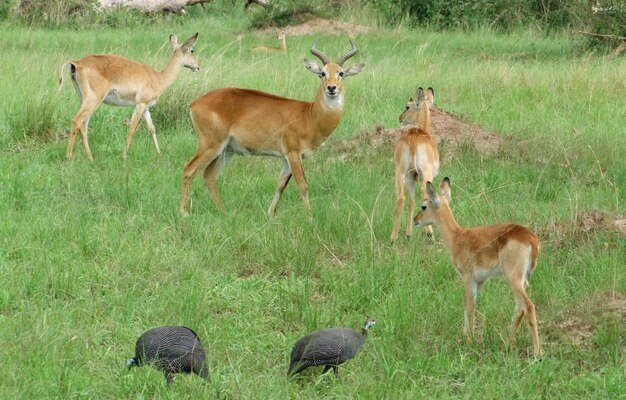
Imagine walking through a vast landscape where the horizon seems endless, and the air is filled with the sounds of nature. This is the world of Ugandan kobs, where they roam and thrive. But their world isn’t just any patch of land—it’s a carefully chosen habitat that offers them everything they need. From the lush grasslands to their seasonal migrations, understanding where these majestic animals live is like piecing together a fascinating puzzle of nature.
Ugandan Kob: An Overview
Before we dive deep into where Ugandan kobs live, let’s take a moment to get acquainted with them. These antelopes are medium-sized and belong to the family Bovidae. They’re known for their long, slender legs and impressive horns, especially the males, which can grow up to 90 centimeters long. You might be wondering why they’re so significant. Well, Ugandan kobs are not only beautiful but also serve as an essential part of their ecosystem, acting as prey for larger predators like lions and leopards.
Kobs are social creatures, often found in groups ranging from a few to over a hundred. This social behavior helps them stay safe from predators and allows them to graze effectively on the abundant grasses of their habitats. They’re also known for their energetic leaps and bounds, which can look quite entertaining, almost like they’re dancing across the plains. Their antics can make you chuckle, reminding us that nature is full of surprises.
Natural Habitat of Ugandan Kobs
Ugandan kobs primarily inhabit open grasslands and savannas. These areas provide the lush grasses that make up their diet, which is largely herbivorous. Imagine a rolling landscape, dotted with tall grasses swaying in the wind. This is not only a feast for the kobs but also a place where they can easily spot any approaching dangers. They thrive in regions with mixed woodland and grassland, allowing them to find shelter when needed.
Besides just grass, these areas also support a variety of other plants and wildlife, creating a rich ecosystem. You might find herds of elephants or groups of zebras sharing the same space, which adds to the vibrancy of their habitat. The variety of flora also means there’s a lot of life happening around them, making it a fascinating place to observe.
Seasonal Migrations
Interestingly, Ugandan kobs are known for their seasonal migrations. They tend to move based on the availability of food and water, which directly influences where they live at different times of the year. During the wet season, you might find them in areas with abundant grass and water sources, while in the dry season they’ll often move to regions that still have some greenery or access to water holes.
This behavior isn’t just about finding food; it’s a survival strategy. Staying mobile helps them avoid overcrowding and reduces competition for resources. Plus, it keeps them on the move, which is great for maintaining healthy populations. Think of it as a natural rhythm, where the kobs are in tune with the cycles of the environment.
Geographical Distribution of Ugandan Kobs
You might be curious where exactly in Uganda these kobs call home. Well, they’re mainly found in the grasslands of the East African region. More specifically, Murchison Falls National Park and Kidepo Valley National Park are two prime spots where you can see them in their natural habitat.
Both parks boast vast expanses of grasslands that are perfect for Ugandan kobs. Murchison Falls, for instance, offers not just grass but also vibrant ecosystems surrounding the Nile River. Meanwhile, Kidepo Valley, with its scenic landscapes and varied wildlife, is a little gem that attracts tourists and researchers alike.
Population and Conservation Status
The population of Ugandan kobs is generally stable, thanks to the protected areas they inhabit. However, habitat loss due to human activities, such as farming and urbanization, poses a significant threat. Conservation efforts are crucial to ensuring that these beautiful animals continue to thrive in their natural environments.
Organizations like the Uganda Wildlife Authority work tirelessly to maintain the habitats of Ugandan kobs while also promoting tourism, which brings in much-needed funds for conservation. If you ever get the chance to visit, your presence helps support these initiatives, making a difference for the kobs and their surroundings.
Behavior and Adaptations in Their Habitat
Ugandan kobs have developed various adaptations that enable them to thrive in their grassy homes. Firstly, their keen eyesight allows them to spot predators from a distance. Their long legs are perfect for quick escapes, enabling them to sprint away quickly when danger approaches. You might envision a kob leaping gracefully away from a lurking lion, using speed and agility to stay out of reach.
Additionally, their social behavior plays a vital role in survival. By living in groups, they can keep watch for predators while grazing. This communal lifestyle not only protects them but also fosters social bonds within the herd. Honestly, it’s heartwarming to see such cooperation in the animal kingdom.
Challenges and Threats to Their Habitat
Despite their resilience, Ugandan kobs face several challenges in their habitat. One significant threat comes from human encroachment, which leads to habitat destruction. As farms expand and towns grow, the natural grasslands where kobs thrive diminish. It’s like squeezing a balloon; eventually, something has to give.
Poaching is another issue that impacts their populations, even though it’s illegal. Some people hunt kobs for meat or trophies, which can reduce their numbers, especially in areas where law enforcement is less effective. Conservation efforts are essential here to educate local communities about the value of protecting wildlife, including the Ugandan kob.
The Role of Ugandan Kobs in Their Ecosystem
Ugandan kobs do more than just add beauty to their landscape; they play important roles in their ecosystems. As herbivores, they help maintain the balance of plant life in their habitat. By grazing on grasses, they prevent certain species from taking over, allowing a diversity of plants to thrive. This, in turn, supports other wildlife that depends on a variety of plants for food and shelter.
Their presence also supports the food chain. Predators such as lions and hyenas depend on kobs as a food source. If kobs were to disappear, it could lead to a cascade of effects on the entire ecosystem. So, you could say that keeping Ugandan kobs safe is not just about protecting a single species—it’s about maintaining the health of their entire environment.
In conclusion, the Ugandan kob is a remarkable creature that embodies the beauty and complexity of nature. Their habitats, from the open grasslands to the stunning national parks, provide them with essential resources for survival. By understanding where they live and the challenges they face, we can better appreciate their role in our world and contribute positively to their conservation. So, the next time you think about Ugandan kobs, remember it’s not just about the antelope itself but the rich tapestry of life they represent.

